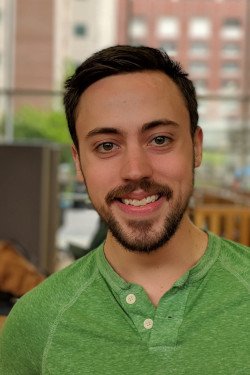Matthew Yankowitz
2019 Regional Award Finalist — Post-Doc

Current Position:
Assistant Professor
Institution:
University of Washington (Previously, Columbia University)
Discipline:
Condensed Matter Physics

Current Position:
Assistant Professor
Institution:
University of Washington (Previously, Columbia University)
Discipline:
Condensed Matter Physics
Recognized for: Groundbreaking experimental work with a new class of two-dimensional materials, known as van der Waal materials, and for modifying their electronic properties with applied pressure. The work has led to the discovery of pressure-induced superconductivity in multi-layer graphene, and has significantly advanced a new area of research, recently coined “twistronics.”
Areas of Research Interest and Expertise: 2D Materials, Condensed Matter Physics, Graphene, Superconductivity, Scanning Tunneling Microscopy
Previous Positions:
PhD, University of Arizona
BS, Stanford University
Research Summary:
Dr. Yankowitz is an experimental condensed matter physicist exploring new electronic phenomena in a unique class of two-dimensional materials, known as van der Waal (vdW) materials. van der Waal materials can be isolated down to a single atomic layer thick, and exhibit unique electronic properties. These novel materials have garnered tremendous interest due to the exotic electronic states they host, as well as for the incredible promise they show for use in novel optoelectronic and electronic devices, including next-generation computing and telecommunications technologies. A major thrust in Dr. Yankowitz’s research has been the development of breakthrough experimental techniques that allow him to tune and manipulate the electronic properties of vdW materials utilizing extreme pressures, ultra-cold temperatures, and high magnetic fields. Under these experimental conditions, Dr. Yankowitz explores the new physics that emerges when these vdW materials are combined and stacked into composite structures, also known as heterostructures. His breakthroughs in experimentation have led directly to the discovery of unique and exotic physics, including the ability to tune the electronic properties of twisted bilayer graphene by applying hydrostatic pressure to make it behave either as a metal that conducts electricity, or as an electrical insulator, or even as a superconductor in which electricity flows without resistance. Dr. Yankowitz’s foundational advances are pushing the forefront of discovery in experimental physics, and have ignited excitement within the field of condensed matter physics, particularly within a new area of research recently coined “twistronics.”
"Quantum materials are emerging as an exciting new platform for probing fundamental questions in physics. My research utilizes two-dimensional van der Waals materials to investigate and directly control exotic quantum mechanical phenomena. In addition to understanding how electrons behave under extreme conditions, these quantum materials are promising for developing groundbreaking new technologies."
Key Publications:
H. Polshyn, M. Yankowitz, S. Chen, Y. Zhang, K. Watanabe, T. Taniguchi, C. R. Dean, and A. F. Young. Large linear-in-temperature resistivity in twisted bilayer graphene. Nature Physics, 2019.
M. Yankowitz, S. Chen, H. Polshyn, Y. Zhang, K. Watanabe, T. Taniguchi, D. Graf, A. F. Young, and C. R. Dean. Tuning superconductivity in twisted bilayer graphene. Science, 2019.
M. Yankowitz, J. Jung, E. Laksono, N. Leconte, B. L. Chattari, K. Watanabe, T. Taniguchi, S. Adam, D. Graf, and C. R. Dean. Dynamic band-structure tuning of graphene moiré superlattices with pressure. Nature, 2018.
M. Gustafsson, M. Yankowitz, C. Forsythe, D. Rhodes, K. Watanabe, T. Taniguchi, J. Hone, X. Zhu and C. R. Dean. Ambipolar Landau levels and strong band-selective carrier interactions in monolayer WSe2. NatureMaterials, 2018.
Other Honors:
2013 & 2015 College of Science Galileo Circle Scholar, University of Arizona
2014 & 2015 Graduate College Fellowship in Physics, University of Arizona
2014 TRIF Imaging Fellowship, University of Arizona
In the Media:
Physics World – Squeezed graphene becomes a superconductor
Fields Magazine – Twisted Physics
Nature Magazine – How ‘magic angle’ graphene is stirring up physics
Quanta Magazine – With a Simple Twist, a “Magic” Material Is Now the Big Thing in Physics
IEEE Spectrum – Engineered Bandgap Pushes Graphene Closer to Displacing Silicon